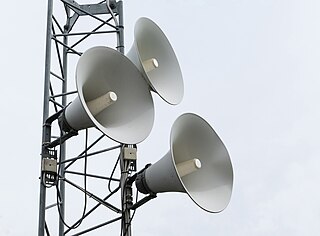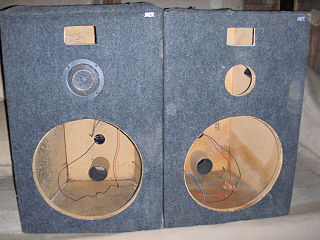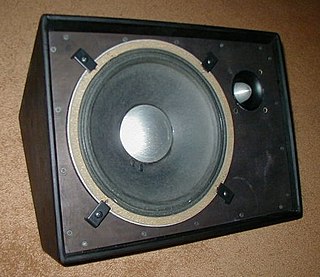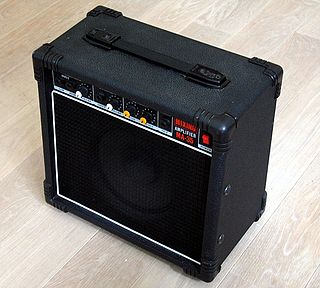Related Research Articles

A subwoofer is a loudspeaker designed to reproduce low-pitched audio frequencies, known as bass and sub-bass, that are lower in frequency than those which can be (optimally) generated by a woofer. The typical frequency range that is covered by a subwoofer is about 20–200 Hz for consumer products, below 100 Hz for professional live sound, and below 80 Hz in THX-certified systems. Thus, one or more subwoofers are important for high-quality sound reproduction as they are responsible for the lowest two to three octaves of the ten octaves that are audible. This very low-frequency (VLF) range reproduces the natural fundamental tones of the bass drum, electric bass, double bass, grand piano, contrabassoon, tuba, in addition to thunder, gunshots, explosions, etc.

A loudspeaker is a combination of one or more speaker drivers, an enclosure, and electrical connections. The speaker driver is an electroacoustic transducer that converts an electrical audio signal into a corresponding sound.

In physics, scattering is a wide range of physical processes where moving particles or radiation of some form, such as light or sound, are forced to deviate from a straight trajectory by localized non-uniformities in the medium through which they pass. In conventional use, this also includes deviation of reflected radiation from the angle predicted by the law of reflection. Reflections of radiation that undergo scattering are often called diffuse reflections and unscattered reflections are called specular (mirror-like) reflections. Originally, the term was confined to light scattering. As more "ray"-like phenomena were discovered, the idea of scattering was extended to them, so that William Herschel could refer to the scattering of "heat rays" in 1800. John Tyndall, a pioneer in light scattering research, noted the connection between light scattering and acoustic scattering in the 1870s. Near the end of the 19th century, the scattering of cathode rays and X-rays was observed and discussed. With the discovery of subatomic particles and the development of quantum theory in the 20th century, the sense of the term became broader as it was recognized that the same mathematical frameworks used in light scattering could be applied to many other phenomena.
A woofer or bass speaker is a technical term for a loudspeaker driver designed to produce low frequency sounds, typically from 20 Hz up to a few hundred Hz. The name is from the onomatopoeic English word for a dog's deep bark, "woof". The most common design for a woofer is the electrodynamic driver, which typically uses a stiff paper cone, driven by a voice coil surrounded by a magnetic field.

Conversation is interactive communication between two or more people. The development of conversational skills and etiquette is an important part of socialization. The development of conversational skills in a new language is a frequent focus of language teaching and learning. Conversation analysis is a branch of sociology which studies the structure and organization of human interaction, with a more specific focus on conversational interaction.

A public address system is an electronic system comprising microphones, amplifiers, loudspeakers, and related equipment. It increases the apparent volume (loudness) of a human voice, musical instrument, or other acoustic sound source or recorded sound or music. PA systems are used in any public venue that requires that an announcer, performer, etc. be sufficiently audible at a distance or over a large area. Typical applications include sports stadiums, public transportation vehicles and facilities, and live or recorded music venues and events. A PA system may include multiple microphones or other sound sources, a mixing console to combine and modify multiple sources, and multiple amplifiers and loudspeakers for louder volume or wider distribution.

A bowling alley is a facility where the sport of bowling is played. It can be a dedicated facility or part of another, such as a clubhouse or dwelling house.

A sound reinforcement system is the combination of microphones, signal processors, amplifiers, and loudspeakers in enclosures all controlled by a mixing console that makes live or pre-recorded sounds louder and may also distribute those sounds to a larger or more distant audience. In many situations, a sound reinforcement system is also used to enhance or alter the sound of the sources on the stage, typically by using electronic effects, such as reverb, as opposed to simply amplifying the sources unaltered.

MartinLogan (ML) is a Canadian/US company producing conventional subwoofer speakers as well as floor-standing, wall-mounted, and in-wall hybrid speakers using electrostatic loudspeaker and planar magnetic thin film loudspeaker technology.
A bass reflex system is a type of loudspeaker enclosure that uses a port (hole) or vent cut into the cabinet and a section of tubing or pipe affixed to the port. This port enables the sound from the rear side of the diaphragm to increase the efficiency of the system at low frequencies as compared to a typical sealed- or closed-box loudspeaker or an infinite baffle mounting.

A loudspeaker enclosure or loudspeaker cabinet is an enclosure in which speaker drivers and associated electronic hardware, such as crossover circuits and, in some cases, power amplifiers, are mounted. Enclosures may range in design from simple, homemade DIY rectangular particleboard boxes to very complex, expensive computer-designed hi-fi cabinets that incorporate composite materials, internal baffles, horns, bass reflex ports and acoustic insulation. Loudspeaker enclosures range in size from small "bookshelf" speaker cabinets with 4-inch (10 cm) woofers and small tweeters designed for listening to music with a hi-fi system in a private home to huge, heavy subwoofer enclosures with multiple 18-inch (46 cm) or even 21-inch (53 cm) speakers in huge enclosures which are designed for use in stadium concert sound reinforcement systems for rock music concerts.
An isobaric loudspeaker is a loudspeaker in which two or more identical woofers operate simultaneously, with a common body of enclosed air adjoining one side of each diaphragm. They are most often used to improve low-end frequency response without increasing cabinet size, though at the expense of cost and weight. Isobaric loudspeakers were first introduced by Harry F. Olson in the early 1950s.

Bass traps are acoustic energy absorbers which are designed to damp low-frequency sound energy with the goal of attaining a flatter low-frequency (LF) room response by reducing LF resonances in rooms. They are commonly used in recording studios, mastering rooms, home theatres and other rooms built to provide a critical listening environment. Like all acoustically absorptive devices, they function by turning sound energy into heat through friction.
Organizational conflict, or workplace conflict, is a state of discord caused by the actual or perceived opposition of needs, values and interests between people working together. Conflict takes many forms in organizations. There is the inevitable clash between formal authority and power and those individuals and groups affected. There are disputes over how revenues should be divided, how the work should be done, and how long and hard people should work. There are jurisdictional disagreements among individuals, departments, and between unions and management. There are subtler forms of conflict involving rivalries, jealousies, personality clashes, role definitions, and struggles for power and favor. There is also conflict within individuals – between competing needs and demands – to which individuals respond in different ways.

JL Audio is an American manufacturer of consumer audio products. Known as one of the pioneers of the car audio industry, it manufactures marine, home, and mobile audio products, but are best known for their subwoofers.

A stage monitor system is a set of performer-facing loudspeakers called monitor speakers, stage monitors, floor monitors, wedges, or foldbacks on stage during live music performances in which a sound reinforcement system is used to amplify a performance for the audience. The monitor system allows musicians to hear themselves and fellow band members clearly.

Small talk is an informal type of discourse that does not cover any functional topics of conversation or any transactions that need to be addressed. In essence, it is polite and standard conversation about unimportant things.

A keyboard amplifier is a powered electronic amplifier and loudspeaker in a wooden speaker cabinet used for the amplification of electronic keyboard instruments. Keyboard amplifiers are distinct from other types of amplification systems such as guitar amplifiers due to the particular challenges associated with making keyboards sound louder on stage; namely, to provide solid low-frequency sound reproduction for the deep basslines that keyboards can play and crisp high-frequency sound for the high-register notes. Another difference between keyboard amplifiers and guitar/bass amplifiers is that keyboard amps are usually designed with a relatively flat frequency response and low distortion. In contrast, many guitar and bass amp designers purposely make their amplifiers modify the frequency response, typically to "roll-off" very high frequencies, and most rock and blues guitar amps, and since the 1980s and 1990s, even many bass amps are designed to add distortion or overdrive to the instrument tone.

Fred Roy Cizek was an American inventor, hi-fi designer, and manufacturer.
Thomas J. Danley is an American audio engineer, electrical engineer and inventor, the holder of multiple patents for audio transducers, especially high-linearity, high-output professional horn loudspeaker systems. Danley first gained notice in the 1980s with his novel servomotor-driven subwoofer systems used to reproduce very low frequencies in concert tours and theme parks. In 2000 he advanced the implementation of multiple-entry horns in 2000 with several designs led by the SPL-td1, a seven-driver loudspeaker. In 2005, he started a new company, Danley Sound Labs, through which he patented further technologies and produced a wide variety of loudspeaker models based on these technologies.
References
- ↑ Brusi, Joe: The "Power Alley" - Discussion & Solutions To The Troubling Interaction Of Subwoofer Stacks, https://www.prosoundweb.com/the-power-alley-discussion-solutions-to-the-troubling-interaction-of-subwoofers/
- ↑ Pādrick, Tim: Subwoofer Info, http://www.padrick.net/LiveSound/SubwooferInfo.htm